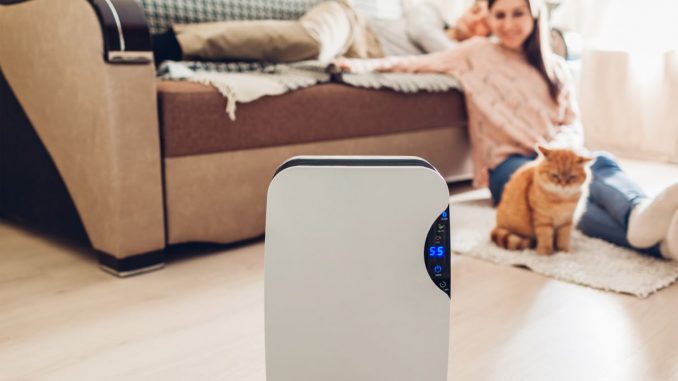
Have you been wondering: how big of a dehumidifier do I need for my home? If so, we’ll explain how to find the perfect dehumidifier size for every space, in a bid to encourage better indoor air quality.
As Kyle Knappenberger, the Director of Technology at US-based air quality company, EnviroKlenz, told Live Science: “Dehumidifiers work by removing water moisture from the air. This helps to improve indoor air quality which in turn helps reduce the likelihood that mold, bacteria, and fungi can take up residence in the area, as they prefer moist environments for growth.”
But finding the best dehumidifiers for your home will depend on how damp your space is and the size of the area you are trying to dry. We’ll be exploring why size matters, how it relates directly to the quality of air in your home and whether or not a dehumidifier can be too big for your space. Plus, you can find some great discounts on dehumidifiers on sale right here at Live Science.
How big of a dehumidifier do I need?
Just like most household appliances, dehumidifiers come in a range of sizes. From heavy industrial-grade units to small, barely noticeable models you can perch in tight and damp corners of your home. But there’s no one-size fits all when it comes to dehumidifiers.
A dehumidifier’s size is based on its total moisture-removal capacity – which is measured in pints during a 24-hour period. Most experts believe a relative humidity (RH) level of 30-50% is ideal. The RH level is the percentage that represents the amount of water vapor in the air – and decreasing your space’s RH level is something dehumidifiers can help you achieve.
Picking the right-sized dehumidifier depends on the total square footage of your space and how high the RH level is. As a general rule of thumb, the larger and damper the space, the bigger capacity your dehumidifier should have.
To put that into perspective, indoor air quality specialists, Sylvane suggest:
· Small 300 square foot spaces with 50-60% RH levels require a 20 pint capacity dehumidifier
· Small 300 square foot spaces with 80-100% RH levels require a 25-30 pint capacity dehumidifier
· 500 square foot spaces with 50-60% RH levels require a 25-30 pint capacity dehumidifier
· 500 square foot spaces with 80-100% RH levels require a 35-40 pint capacity dehumidifier
· 800 square foot spaces with 50-60% RH levels require a 35-40 pint capacity dehumidifier
· 1,200 square foot spaces with 50-60% RH levels require a 50 pint capacity dehumidifier
· 1,200 square foot spaces with 80-100% RH levels require a 60 pint capacity dehumidifier
If it’s only one room that’s damp and it has high water moisture levels – such as a laundry room or bathroom – you can get away with one dehumidifier in your home. However if you need to lower the RH levels throughout your whole house, you should invest in a whole-house dehumidifier with a big capacity to keep the RH percentage under control.
Why does dehumidifier size matter?
Dehumidifier size matters because overall, this will determine how much water vapor the machine can take out of the air in a 24-hour period.
As stated by Energy Star, if you have an extremely wet 500 square foot space, a 10 pint capacity dehumidifier won’t make a dent on the air quality. That’s because it won’t be able to remove the high levels of water moisture from the air.
High levels of moisture can encourage biological pollutants, including allergens such as mold, mildew, dust mites and cockroaches. These all have a negative impact on the levels of indoor air quality. Plus, the U.S Environmental Protection Agency believes that dampness in homes can cause adverse health effects including the likes of: upper-respiratory symptoms, coughing, wheezing, asthma development and shortness of breath.
So if you get a dehumidifier that’s too small for your damp space, it won’t help you decrease the levels of moisture in your home. If in doubt, ask a professional who will be able to help you find a suitable dehumidifier that’s the perfect size for your room.
Can a dehumidifier be too big?
According to Becca Dodds from the Analox Group – a UK-based company that helps to ventilate spaces – yes: a dehumidifier can be too big for your space and the amount of humidity levels you are dealing with.
Dodds told us: “If you get a dehumidifier that is too large for the space then there is the possibility that it will make the air excessively dry and uncomfortable to be around.” Excessive dryness in your home can have negative connotations for your skin and indoor living organisms such as plants. Remember: the goal is to keep the humidity levels in your home at around 30-50%.
Plus, if the dehumidifier model is too big for your home, it will take up unnecessary floor space, when in fact you could get away with a smaller, more compact unit.
Investing in a bigger dehumidifier can have some pros, as it can suck out the moisture from the air quicker than a smaller capacity machine. This is great for your electricity bills as it will lessen the amount of time you need to leave your dehumidifier on. However, when it comes to choosing the right size dehumidifier for your space, we’d suggest taking into consideration the size of your room and the RH levels you are dealing with.
Becks Shepherd
Becks is a freelance journalist and writer writing for a range of titles including Stylist, The Independent and LiveScience covering lifestyle topics such as health and fitness, homes and food. She also ghostwrites for a number of Physiotherapists and Osteopaths. When she’s not reading or writing, you’ll find her in the gym, learning new techniques and perfecting her form.
Source: Read Full Article
